|
Chapter Five
STRANGERS FROM
ACROSS THE SEAS
"When the
Toltecs under their leader Topiltzin-Quetzalcoatl left
Tollan in A.D. 987, disgusted by the religious abominations and
seeking a place where they could worship as in the olden days, they
went to Yucatan. Surely they could have found a new home closer by,
a less arduous journey, a passage through less hostile tribes. Yet
they chose to trek almost a thousand miles, to a land different in
all respects - flat, riverless, tropical - from their own. They did
not stop until they had reached Chichen Itza. Why? What was the
imperative in reaching the sacred city that the Maya had already
abandoned? We can only search the ruins for an answer.
Chichen Itza, easily reached from
Merida.... it was the jungle
canopy that had to be removed....
"....Rewarding the visitor with a double treat: a visit to an
"Old
Empire" Maya city and to a mirror image of Tollan as its emigrants
had last seen it; for when the Toltecs arrived, they rebuilt and
built over Chichen Itza in the image of their erstwhile capital.
"Archaeologists believe that the site was an important settlement
even in the first millennium B.C.... Most of the visible remains
from the era of Maya dominion are located in the southern or "Old Chichen" part of the site.... Last to occupy (or rather, reoccupy)
Chichen Itza before the arrival of the Toltecs were
the Itzas, a
tribe that some believe were kinsmen of the Toltecs and others see
as emigrants from the south. It is they who gave the place its
current name, meaning "The Well Mouth of the Itzas."
Among the many features of
Chichen Itza, Mr. Sitchin mentions:
The image of Chacmool and of a jaguar, which the
Toltecs installed.
"As at Tula (Tollan), facing the
pyramid of Quetzalcoatl-Kukulcan,
across the main plaza is the main ball court. It is an immense
rectangular arena, 545 feet long - the largest in Mesoamerica. High
walls rise along the two long sides; at the center of each,
thirty-five feet above the ground, there protrudes a stone ring
decorated with carvings of entwined serpents. To win the game the
ballplayers have to throw a ball of solid rubber through the rings.
There were seven players in each team; the team that lost paid a
heavy price: its leader was decapitated.
"....The severe end suggests that there was more than play and
entertainment to this ball game. At Chichen Itza, as at
Tula, there
were several ball courts, perhaps for training or lesser matches.
The main ball court was unique in its size and splendor, and the
importance of what took place in it was underscore by the fact that
it was provided with three temples that were richly decorated with
scenes of warriors, mythological encounters, the Tree of Life, and a
winged and bearded deity with two horns.
|
 |

Chac-Mool at Temple of Warriors, Chichen Itza
|
|

Ball Court, Chichen Itza
|
 |
"All this, and the diversity and regalia of the ball players,
suggest to us an intertribal, if not international, aspect of an
event of great political - religious significance. The number of
players (seven), the decapitation of the losers’ leader, and the use
of a rubber ball seem to mimic a mythological tale in
the Popol Vuh
of a combat between the gods conducted as a contest with a rubber
ball. It pitched the gods Seven-Macaw and his two sons against
various Sky Gods, including the Sun, Moon, and
Venus. The defeated
son Seven-Huanaphu was executed: "His head was cut off from his body
and rolled away, his heart was cut out from his chest." But being a
god, he was resurrected and became a planet.
"Such a reenactment of godly events would have made the
Toltec
custom akin to religious plays in the ancient Near East. In
Egypt,
the dismemberment and resurrection of Osiris was reenacted annually
in a mystery play in which actors, including the pharaoh, played the
roles of various gods; and in Assyria, a complex play, also
performed annually, reenacted a battle between two gods in which the
loser was executed, only to be pardoned and resurrected by the
God
of Heaven. In Babylon,
Enuma Elish, the epic describing the creation
of the solar system, was read annually as part of the New Year’s
celebrations; it depicted the celestial collision that led to the
creation of Earth (the Seventh Planet) as the cleaving and
decapitating of the monstrous Tiamat by the supreme Babylonian god
Marduk.
"The Maya myth and its reenactment, in echoing
Near Eastern "myths"
and their reenactments, appear to have retained the celestial
elements of the tale and the symbolism of the number seven as it
relates to the planet Earth. It is significant that in the
Mayan-Toltec depictions along the walls of the ball court, some
players carry as their emblem the Sun Disk, while others carry that
of a seven-pointed star. That this was a celestial symbol and not
just a chance emblem is confirmed, in our opinion, by the fact that
elsewhere in Chichen Itza a four-pointed star was repeatedly
depicted in combination with the "eight" symbol for the planet
Venus
and that at other sites in northwestern Yucatan temple walls were
decorated with symbols of six-pointed stars.
"The depictions of planets as pointed stars is so common that we
tend to forget how this custom had arisen: As so much else, it began
in Sumer. Based on what they had learned from
the Nefilim, the
Sumerians counted the planets not as we do, from the Sun outward,
but from the outside in.
|

Museum at Merida.
|
"....We find the
Sumerian method much more elegant and accurate, and
suggest that the Maya/Toltec depictions followed the Near Eastern
iconography; for, as one can see, the symbols found at Chichem Itza
and elsewhere in Yucatan are almost identical to those by which the
various planets had been depicted in Mesopotamia.
Valuable sculptures with more "stars" are kept in the
Museum at Merida, like the one found at Tzekelna. Also at
Oxkintok, a female
figure, as counterpart of the one mentioned above, both are given
suggestions of being Water Gods.
"....The focal point of the worship of
Itzamna (the god of the Itzas)
and Quetzalcoatl, and perhaps also of the memories of Votan, was the
Sacred Cenote of Chichen Itza - a huge well that gave
Chichen Itza
its name.
Continuing with the
story about the Cenote of Chichen Itza....
|

North Section of Chichen Itza.
|
" In 1885, Edward H. Thompson, after purchasing one hundred square
miles of jungle, which included Chichen Itza.... he organized for
the Peabody Museum of Harvard University systematic dives into
the
well to retrieve its sacred offerings.... More than 3,400 objects
were made of jade.... more than 500 objects bore carvings depicting
animals and people. Among the latter, some were clearly bearded,
resembling depictions on the temple walls of the ball court.
"Even more significant were the metal objects that the divers
brought up. Hundreds were made of gold, some of silver or
copper -
significant finds in a peninsula devoid of metals. Some of the
objects were made of guilded copper or copper alloys, including
bronze, revealing a metallurgical sophistication unknown in the Maya
lands and attesting that the objects had been brought from distant
lands. Most puzzling of all was the discovery of disks of pure tin,
a metal that it is not found in its native state and that can be
obtained only by a complex refining of ores - ores that are
altogether absent in Mesoamerica.
"....Most important, disks with engraved or embossed with encounter
scenes. In these, persons in different garbs and of diverse features
confront each other, perhaps in combat, in the presence of
terrestrial or celestial serpents of Sky Gods. The dominant or
victorious hero is always depicted bearded.
"....The identity of these
bearded people is a puzzle; what is
certain is that they were not native Indians, who grow no facial
hair and have no beards. Who, then, were these foreigners? Their
"Semitic" or rather Eastern Mediterranean features (even more
prominent in clay objects bearing facial images) have led various
researchers to identify them as Phoenicians or "seafaring Jews,"
perhaps blown off course and carried by the Atlantic’s currents to
the shores of Yucatan when King Solomon and the
Phoenician king
Hiram joined forces to send maritime expeditions around Africa in
search of gold (circa 1000 B.C.); or a few centuries later, when the
Phoenicians were driven away from their port cities in the eastern
Mediterranean, established Carthage, and sailed to western Africa.
"No matter who the seafarers might have been and the proposed
crossing time, established academic researchers dismiss out of hand
any notion of deliberate crossings. They either explain the obvious
beards as false beards, artificially attached by the Indians to
their chins, or as belonging to the chance survivors of shipwrecks.
Clearly, the first argument (seriously made by renowned scholars)
only begs the question: if the Indians emulated some other bearded
people, who were those other people?
"Nor does the explanation of a few shipwrecked survivors seem valid.
The native traditions, as in the legend of Votan, speak of repeated
voyages, of exploration followed by settlement (the establishment of
cities). The archaeological evidence belies the notion of a few
chance survivors cast on a single shore. The Bearded Ones, in poses
of a variety of activities and circumstances, have been depicted at
sites all along the Mexican gulf coast, at inland locations, and as
far south as the Pacific coast. Not stylized, not mythified, but as
portraits of actual individuals.
"Some of the most striking examples of such depictions have been
found in Veracruz. The people they immortalize are clearly identical
to West Semitic dignitaries taken prisoner by Egyptian pharaohs
during their Asiatic campaigns, as depicted by the victors in their
commemorative inscriptions upon temple walls.
"Why, and when, did such
Mediterranean seafarers come to
Mesoamerica? The archaeological clues are baffling, for they lead to
an even greater enigma: the Olmecs, and their apparent
black African
origins; for, as many depictions - as the one from Alvarado,
Veracruz - show, the Bearded Ones and the
Olmecs had met, face to
face, in the same domain and at the same time.
|

Olmec Colossal Heads
|
 |
"Of all the lost civilizations of
Mesoamerica, that of the Olmecs is
the oldest and the most mystifying. It was by all counts the Mother
Civilization, copied and adapted by all the others. It dawned along
the Mexican coast at the beginning of the second millennium B.C.
(or, some hold, by 1500 B.C.). Spreading in all directions, but
mainly southward, it made its mark along Mesoamerica
by 800 B.C.
"The first Mesoamerican glyphic writing appears in
the Olmec realm;
so does the Mesoamerican system of numeration, of dots and bars. The
first Long Count calendar inscriptions, with the enigmatic starting
date in 3113 B.C.; the first works of magnificent and monumental
sculpted art; the first use of jade; the first depictions of
hand-held weapons or tools; the first ceremonial centers; the first
celestial orientations - all were achievements of the Olmecs....
they have been compared to the Sumerians in Mesopotamia, which
accounted for all the "firsts" in the ancient Near East. And, like
the Sumerian civilization, the Olmecs too appeared suddenly, without
a precedent or a prior period of gradual advancement.... The Olmecs
expressed their "myths" in sculptured art, as on the
stela from
Izapa of one winged god beheading another. The tale-in-stone is
remarkably similar to a Sumerian depiction.
"Unique in all aspects are giant stone heads sculpted with
incredible skill and unknown tools to portray Olmec leaders. The
first to see such a gigantic head was J.M. Melgar y Serrano at
Tres
Zapotes in the state of Veracruz. He described it in the
Bulletin of
the Mexican Geographical and Statistical Society (in 1869) as "a
work of art.... a magnificent sculpture that most amazingly
represents an Ethiopian." Accompanying drawings faithfully
reproduced the head’s negroid features.
The heads measure about
eight feet high, twenty-one in
circumference, and weigh about twenty-four tons.
"It depicts without question a negroid African wearing a distinct
helmet. In time, additional such heads, each portraying a distinctly
different individual with his own different helmet but with the same
facial features, were found at La Venta.
"....By now sixteen such colossal heads have been found....
radiocarbon readings gave dates to circa 1200 B.C.... That these
were individuals all of the same African negroid stock but with
their own personalities and diverse headgear, can be readily seen
from a portrait gallery of some of these heads.... "giants" in
stature, no doubt in the eyes of the indigenous Indian
population.... some terracotas and even some more so stone
sculptures of the Olmecs portray them as holding babies - an act
that must held special significance for them.
Extraordinary finds at
La Venta (which shows "that it was a small
island in the swampy coastal area, has been artificially shaped,
landfilled and built up according to a preconceived plan, a place
devoid of stones; major edifices have been laid out with great
geometric precision along a north-south axis, extending for about
three miles"), have been found, and Mr. Sitchin gives a good
description of them in his book.
"At any rate, the insistence of the employment of great blocks of
stone, even if it had to be brought from afar, for monuments,
commemorative sculptures, and burials must serve as a clue to the
enigmatic origin of the Olmecs.
|

Olmec Priest with Infant
|

Olmec Ceramic "Baby" Figurine.
|
"No less puzzling was
the discovery at La Venta of hundreds of artistically carved objects
of the rare jade, including unusual axes made of this semiprecious
stone that is no locally available. Then, to add to the mystery they
were all deliberately buried in long, deep trenches. The trenches,
in turn, were filled with layers of clay, each layer of a different
kind and color of clay - thousands of tons of soil brought over from
diverse distant places. Incredibly, the trenches were paved at the
very bottom with thousands of tiles of serpentine, another
green-blue semiprecious stone. It has been generally assumed that
the trenches were dug to bury in them the precious jade objects; but
the floors of serpentine could also suggest that the trenches were
constructed earlier, for another purpose all together; but were used
to bury highly valued objects, such as rare axes, once the need for
them (and for the trenches) ceased. There is indeed no doubt that
the Olmec sites were abandoned by them around the beginning of the
Christian era and that the Olmecs even attempted to bury some of the
colossal heads. Whoever gained access to their sites afterward, did
so with a vengeance: some of the heads were clearly toppled off
their bases and rolled down-hill into the swamps; others bear marks
of attempted mutilation.
"As another enigma from La Venta, let us note the discovery in the
trenches of concave mirrors of crystallized iron ores (magnetite and
hematite), shaped and polished to perfection. After studies and
experiments scholars at the Smithsonian Institution in Washington,
D.C., have concluded that the mirrors could be used to focus the
sun’s rays, to light fires or for "ritual purposes" (the scholars’
way of saying they do not know what an object was for).
"The final enigma at
La Venta is the site itself, for it is
precisely oriented on a north-south axis that is tilted 8 degrees
west of true north. Various studies have shown that this was an
intentional orientation, intended to permit astronomical sightings,
perhaps from atop the conical "pyramid" whose prominent ridges may
have served as directional indicators. A special study by M. Popenoe-Hatch.
(Papers on Olmec and Maya Archaeology No. 13, University of
California) concluded that,
"the pattern of observation being made at
La Venta at 1000 B.C. indicates that it must date back to a body of
knowledge learned a millennium earlier.... The La Venta site and its
art of 1000 B.C. seem to reflect a tradition based in large part on
the meridian transits of stars occurring in the solstices and
equinoxes around 2000 B.C."
"A beginning at 2000 B.C. would make
La Venta the earliest "sacred
center" in Mesoamerica, preceding Teotihuacan, except for the
legendary time when gods alone were there. It still may not be the
true time of the Olmecs’ arrival from across the seas, for their
Long Count begins at 3113 B.C.; but it does clearly indicate how far
ahead of the renowned civilizations of the Maya and
the Aztecs, the Olmecs had been.
"....Experts in earthworks, masters of stoneworking, diggers of
trenches, channelers of water, users of mirrors - what, thus
endowed, were the Olmecs doing in Mesoamerica?
Stelae show them
emerging from "altars" that represent entrances into the depth of
the earth, or inside caves holding a puzzling array of tools, as on
the Stela from La Venta in which it is possible to discern the
enigmatic mirrors being attached to the toolholder’s helmets.
|

Olmec Sculpture of a Ruler emerging from a cave
|

. |
"All in all, the capabilities, the scenes, the tools appear to us to
lead to one conclusion: the Olmecs were miners,
come to the New
World to extract some precious metals - probably gold, perhaps other
rare minerals too.
"The legends of Votan, which speak of
tunneling through mountains,
support this conclusion. So does the fact that among the Olden Gods
whose worship was adopted from the Olmecs by the
Nahuatl people were
the god Tepeyolloti, meaning "Heart of the Mountain." He was a
bearded God of Caves; his temple had to be of stone, preferably
built inside a mountain. His glyph-symbol was a pierced mountain; he
was depicted holding as his tool a flamethrower - just as we had
seen at Tula!
"Did the Mediterranean Bearded Ones come to
Mesoamerica at the same
time as the African Olmecs? Were they allies, helping each other -
or competitors for the same precious minerals or metals? No one can
say with any certainty; but it is our own belief that the African Olmecs were there first and that the root of their arrival must be
sought in that mysterious beginning date of the Long Count - 3113
B.C.
"No matter when and why the relationship began, it seems to have
ended in a convulsion.
"....Olmec sites seem to have been abandoned gradually, first in the
older "metropolitan center" near the Gulf, circa 300 B.C., then
later on at more southern sites. We have seen the evidence of the
date equivalent to 31 B.C. at Tres Zapotes; it suggests that the
process of the abandonment of Olmec centers, followed by revengeful
destruction, may have lasted several centuries, as the Olmecs gave
up sites and retreated southward.
"The depictions from the turbulent period and from that southern
zone of Olmec domains show them more and more as warriors, wearing
frightening masks of eagles or jaguars. One such rock carving from
the southern areas show three Olmec warriors (two with eagles masks)
holding spears. The scene includes a naked captive who is
bearded.
What is not clear is whether the warriors are threatening the
captive, or are depicted in the act of saving him. This leaves
unclear the intriguing question, were the negroid Olmecs and the
Bearded Ones from the eastern Mediterranean on the same side when
the troubled times shattered Mesoamerica’s first civilization?
"They do seem to have shared, though, the same fate.
"At a most interesting site near the Pacific coast called
Monte
Alban - erected on a vast array of man-made platforms and with
unusual structures built for astronomical purposes - dozens of stone
slabs, erected in a commemorative wall, bear the carved images of
the African-negroid men in contorted positions. For a long time they
were nicknamed Danzantes, "Dancers"; but scholars now agree that
they show the naked bodies of mutilated Olmecs -presumably killed in
a violent uprising by the local Indians. Among the depicted negroid
bodies there is one of a bearded man with a Semitic nose who
obviously shared the fate of the Olmecs.
"Monte Alban is believed to have been a settlement since 1500 B.C.
and a major center since 500 B.C. Thus, within a few of its
grandeur, its builders ended up as mutilated bodies commemorated on
stone - victims of those whom they had tutored.
"And thus did the millennia, the golden age of the
Strangers From
Across the Seas, become just a legend.
|
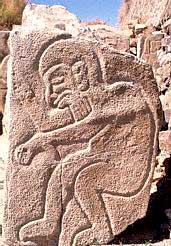
The "Bearded
Man with a Semitic Nose" as given in Mr. Sitchin’s book. |
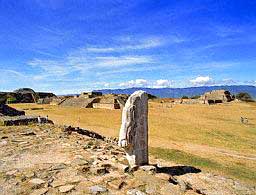
Mount Alban in Oaxaca
|

"Danzante," But now recognized as a mutilated Olmec.
|
Return
Chapter Six
REALM OF THE
GOLDEN WAND
"The story of civilization in the
lands of the Andes is shrouded in
mystery, deepened by the absence of written records or stelae
bearing glyphic tales; but myth and legend fill the canvas with
tales of gods and giants, and kings who had descended of them.
"....Spanish chroniclers, as well as native ones who had learned
Spanish, had established that the father of the two Inca kings at
the time of the conquest, Huayna Capac, was the twelfth Inca ( a
title meaning lord, sovereign) of a dynasty that began in Cuzco, the
capital, circa A.D. 1020. It was just a couple of centuries before
the conquest that the Incas had swooped down from their highland
strongholds to the coastal zones, where other kingdoms had existed
from much earlier times. In extending their dominions northward to
today’s Ecuador and southward to today’s Chile with the aid of the
renowned Highway of the Sun, the Incas essentially superimposed
their rule and administration over cultures and organized societies
that had thrived in those domains for millennia. The last one to
fall under Inca domination was a veritable empire of the Chimu
people; their capital Chan-Chan, was a metropolis whose sacred
precincts, step-pyramids and dwelling compounds spread over eight
square miles.
"Located near the present-day city of
Trujillo, where the river Moche flows into the Pacific Ocean, the ancient capital reminded
explorers of Egypt and Mesopotamia.
"....The coastal areas that lie between the
western range of the
Andes and the Pacific Ocean are climatically rainless areas.
Habitation and civilization was able to flourish there because the
waters flowing off the high mountains into the ocean do so in the
form of rivers large and small that transect the coastal plains
every fifty to one hundred miles or so. These rivers create verdant
and fertile areas that separate one desertlike stretch from the
other. Settlements therefore arose on the banks and at the mouths of
these rivers; and the archaeological evidence shows that the Chimus
augmented these water sources with supplies brought from the
mountains via aqueducts. They also connected the successive fertile
and settled areas by a road that on the average was fifteen feet
wide - the precursor of famed Highway of the Sun of the Incas.
"....Goldsmithing was mastered to an extent never attained by the
subsequent Incas.... The environs of another city (besides Tumbes),
Tucume, have yielded the greater part of the gold objects that had
been found in Peru in the century following the conquest.... Indeed,
the amount of gold the Chimus possessed astounded the
Incas when
they overran the coastlands. Those legendaries quantities, and the
actual finds thereafter, still puzzle scholars; for the gold sources
of Peru are not in the arid coastlands, but in the highlands.
"The Chimu culture-state was in turn the successor of previous
cultures or organized societies. As in the case of Chimu, no one
knows what those people called themselves; the names that are
nowadays applied to them are actually names of archaeological sites
or rivers at which these societies and their recognizable cultures
were centered.
CHIMU
|

Andes Mountain Range.
|

Ruins of Chan Chan, the ancient capital of the Chimu empire. Located
near the modern city of Trujillo. |
|

Rainbow Temple. Chan Chan
|
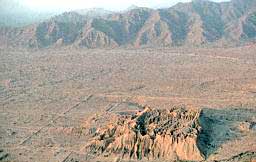
Moche adobe pyramid
|
|
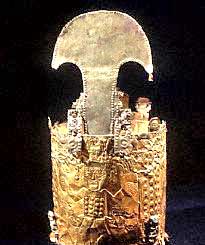
Chimu Gold
Crown |

Relief sculpture of a bird on the latticed walls of an interior
plaza in Chan Chan, the ancient capital of the Chimu State.
|
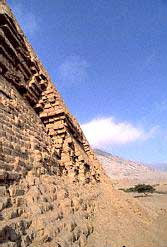
Adobe Pyramid Temple, known as Temple of The Sun, near Trujillo
|
"On the north-central
coastal area, the one called Mochica, rolls back the fog of history
to about 400 B.C. They are known for their artful pottery and
graceful textiles, but how and when these arts were acquired
remains a mystery. The decorations on their ceramic vessels are
replete with illustrations of winged gods and menacing giants, and
suggest a religion with a pantheon headed by the Moon God whose
symbol was the Crescent and name was Si or Si-An.
"The
Mochica artifacts clearly show that, centuries before the
Chimu,
they had mastered the art of casting gold, of building with mud
bricks, and of laying out temple compounds replete with ziggurats.
At a site called Pacatnamu, a buried sacred city with no less than
thirty-one pyramids was excavated in the 1930s by a German
archaeological team.... They determined that the many smaller
pyramids were about a thousand years older than the several much
larger pyramids that had sides of two hundred feet and were forty
feet high.
"The southern border of the Chimu empire was the
river Rimac, from
which name the Spaniards corrupted Lima as the name of their
capital. Beyond this boundary the coastal zones were inhabited, in
pre-Inca times, by Chincha tribesmen; the highlands were occupied by
Aymara-speaking peoples. It is now known that the Incas had obtained
their notions of a pantheon from the former, and the
tales of
Creation and Beginning from the latter.
"The
Rimac region was a focal point in antiquity as it is nowadays.
It was there, just south of Lima, that the largest temple to a
Peruvian deity had stood. Its ruins from the time it was rebuilt and
enlarged by the Incas can still be seen. It was dedicated to Pacha-Camac, meaning "Creator of the World," a god who headed a
pantheon that included the divine couples Vis and Mama-Pacha ("Lord
Earth" and "Lady Earth") and Ni and Mama-Cocha ("Lord Water" and
"Lady Water") the Moon god Si, the Sun God Illa-Ra, and the Hero God
Kon or Con who was also known as Ira-Ya, names that evoke a host of
Near Eastern divine epithets.
MOCHICA
|
 |

Ear decorations with a Warrior
|
|
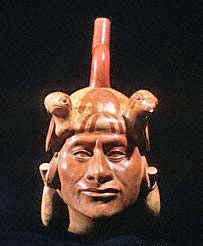
Portrait Stirrup Spout Bottle of a Chief wearing a Bird Helmet
|

Mochica Stirrup Spout Bottle with a Fish
.
|
|

Gold Funerary Hands
|
"The temple of
Pachacamac was a "Mecca" for the ancient peoples of
the ancient coasts. Pilgrims came to it from far and near.... Only
select priests could enter the Holy of Holies where, on certain
holidays, the god’s image pronounced oracles that the priests then
related to the people. But the whole temple precinct was so revered
that pilgrims had to take off their sandals to enter it - just as
Moses was commanded to do in the Sinai and as
Moslems still do as
they enter a mosque.
"....Local agents attribute the
establishment of this temple to the
"giants." What is known for certain is that
the Incas, adopting the
veneration of Pachacamac from tribes they had overrun, enlarged and
embellished the temple.
"....Not only the living came to pray and to worship here, the dead
too were brought to the Rimac valley and the coastal plains to its
south, to spend their afterlife in the shadow of the oracle gods;
perhaps even for an eventual resurrection, for there was a belief
that Rimac could resurrect the dead.... The dry climate and the
outer sack protected the superbly woven garments, shawls, turbans,
and ponchos, and their incredible bright colors. The textiles whose
exquisite weaving reminded archaeologists of Europe’s finest Gobelin
tapestries, were embroidered with religious and cosmological
symbols.
"The central figure, on the textiles as well as on the ceramics, was
always that of a god holding a wand in one hand and a thunder-bolt
in the other and wearing a horned or rayed crown; the Indians called
him Rimac, like the river’s name.
"Were Rimac and
Pachacamac one and the same deity, or two separate
ones? Scholars disagree, for the evidence is inconclusive. They do
agree that the nearby mountain ranges were dedicated exclusively to
Rimac. His name meant "The Thunderer," and thus in meaning and
phonetically is akin to the nickname Raman by which Adad
was known
to the Semitic peoples - an epithet stemming from the verb meaning
"to thunder."
"According to the chronicler
Garcilaso, it was in these mountains
that "an idol, in the shape of a man," had stood in a shrine
dedicated to Rimac. He may have been referring to any of several
sites in the mountains flanking the Rimac valley. There ruins of
what archaeologists believe were step pyramids dominate the scenery
to this very day, fooling the viewer to imagine he is seeing a
seven-step ziggurat in ancient Mesopotamia.
"Was
Rimac the god sometimes called "Kon" or "Ira-Ya," the one
called Viracocha in Inca lore? Though no one can say for certain,
what is beyond doubt is that Viracocha was depicted exactly as the
deity shown on the coastal pottery - holding in one hand the forked
weapon and in the other the magical wand.
"It was with that wand - a
wand of gold - that all Andean legends of
Beginnings commence; on the shores of Lake Titicaca, at a place
called Tiahuanacu.’"
|

Kawachi, Nazca. Ruins containing pyramids, temples and plazas
|

Paredones, Nazca. This was the administrative center of the Incas,
who controlled the Nazca region from the mid 15th century.
(Modern
political graffiti appears on top of the hill). |
|
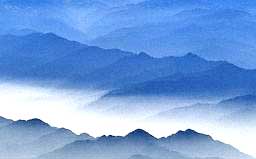
Andes in clouds near Nazca
|

Ray Gods, Nazca
|
|
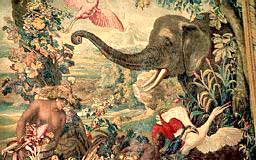
Gobelins Tapestry at the Palace of the Grand Masters, Valletta.
|

Paracas, Llama wool cloth with animal motives.
|
|

Spanish Lithograph Garcilaso de la Vega
|
"When the Spaniards
came, the lands of the Andes were the lands of the Inca empire,
ruled from the highland capital Cuzco.
"And
Cuzco, Inca tales related, was established by the
Children of
the Sun who had been created and instructed at Lake Titicaca by the
Creator God, Viracocha.
"....One of the first padres to record the native tales of their
history and prehistory was Blas Valera; unfortunately, only
fragments of his writings are known from mentions by others, for his
original manuscript was burnt in the sack of Cadiz by the English in
1587. He recorded the Inca version that their first monarch, Manco
Capac, exited from Lake Titicaca through a subterranean way. He was
the son of the Sun and was given by the Sun a golden wand with which
to find Cuzco. When his mother went into labor, the world was in
darkness. When he was born, there was light and trumpets sounded,
and the god Pachacamac declared that "the beautiful day of Manco
Capac had dawned."
"But Blas Valera also recorded
other versions that suggested that
the Incas appropriated to their dynasty the person and tale of
Manco
Capac, and that their true ancestors were immigrants from somewhere
else who had arrived in Peru by sea. According to this, the monarch
called by the Incas "Manco Capac" was the son of a
king called Atau
who had arrived to the Peruvian coast with two hundred men and women
and disembarked at Rimac. From there they went to
Ica, and from
there, they marched to Lake Titicaca, the place from which the
Sons
of the sun had governed the Earth. Manco Capac sent his followers in
two directions to find those legendary Sons of the Sun. He himself
wandered many days until he came to a place that had a sacred cave.
The cave was artificially hewed out and was adorned with gold and
silver. Manco Capac left the sacred cave and went to a window called
Capac Toco, meaning "Royal Window." As he came out, he was dressed
in golden garments he had obtained in the cave; and by putting on
these royal garments he was invested with the kingship of Peru.
|

Lake Titicaca is around 17,000 feet above sea level.
|

Hay on Lake Titicaca shore
Totora Reed, Lake Titicaca, Peru |
|

Island at Lake Titicaca, on Bolivia’s territory
|
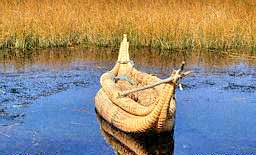
Reed Boat on Lake Titicaca
|
|

Arrival of the First Inca. Part of a celebration of the landing of
the first Inca.
People stand on a platform with a sun decoration on
it. |
"One of the versions regarding the Beginning was that the great god,
Creator of All, Viracocha, arranged for four brothers and four
sisters to roam the land and bring civilization to its primitive
peoples, and one of these brother-sister/husband-wife couples
began
kingship in Cuzco. The other version was that the
Great God, at his
base in Lake Titicaca, created this first royal couple as his
children and gave them an object made of gold. He told them to go
north and build a city where the golden object would sink into the
earth; the place where the miracle had happened was Cuzco. And that
is why the Inca kings - providing they had been born of a succession
of brother-sister royal couples - could claim direct descent of the
Sun God.
"Recollections of the Deluge featured in almost all versions of
Beginning. According to Father Molina (Relacion de las fabulas y
ritos de los Yngas) it was already "in the time of Manco Capac, who
was the first Ynca and from whom they began to be called Children of
the Sun.... that they had a full account of the Deluge....
No living thing survived except a man and a woman who remained in a
box; and when the waters subsided, the wind carried them to Huanaco,
which will be over seventy leagues from Cuzco, a little more or
less. The Creator of All Things commanded them to remain there as
Mitimas, and there in
Tiahuanaco the Creator began to raise up the
people and nations that are in that region...."
"....The Creator also had with him on the
Island of Titicaca the
Moon and the Sun, whence they had come on his orders. When all that
was needed to replenish the Earth was done, the Moon and the Sun
rose up to heaven.
|

Foundations at Tiahuanaco. Pre-Inca ruins, near La Paz, Bolivia.
|

Monolith in
Gateway of Pre-Inca ruins at Tiahuanaco
.
|
|
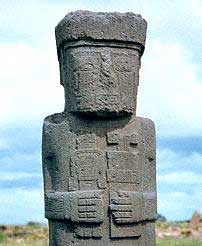
Details of Tiahuanaco Colossus
|

A Figure adorns the Puerta del Sol Gateway |
"The two divine assistants of
the Creator of All are presented in
another version as his two sons. "Having created the tribes and
nations, and assigned dresses and languages to them," Father Molina
wrote, "the Creator ordered his two sons to go in different
directions and introduce civilization." The old son, Ymaymana
Viracocha (meaning "in whose power all things are placed"), went to
give civilization to the mountain peoples; the younger son, Topaco
Viracocha ("maker of things"), was ordered to go by way of the
coastal plains. When the two brothers completed their work they met
at the seashore, "whence they ascended to heaven."
"Garcilaso de la Vega, who was born in
Cuzco to a Spanish father and
an Inca mother soon after the conquest, recorded two legends.
According to one the Great God came down from the heavens to Earth
to instruct mankind, giving it laws and precepts. He "placed his two
children at Lake Titicaca," gave them a "wedge of gold," and
instructed them to settle where it would sink into the ground, which
was at Cuzco. The other legend related that "after the waters of the
deluge had subsided, a certain man appeared in the country of
Tiahuanacu, which is to the south of Cuzco. This man was so powerful
that he divided the world in four parts, and gave them to four men
whom he honored with the title of king." One of them, whose epithet
name was Manco Capac ("king and lord" in the Quechua language of the
Incas), began kingship in Cuzco.
|

Quechua
Indian Mountain Hamlet
. |

Indigenous people march through a Quito street, Ecuador, carrying
the Flag of the Indigenous Peoples of The Andes. |
"....A Quechua tale says
that Viracocha after establishing kingship in Cuzco, he continued
his journey "as far as the coast of Ecuador, where his two
companions joined him. There they all began to walk together on the
waters of the sea, and disappeared."
"Some of the tales of the highland peoples focused on how there had
come to be a settlement at Cuzco, and how Cuzco had been divinely
ordained to become the capital.... Manco Capac found the site of the
city with his pure gold wand, it was called Tupac-yauri, meaning "splendorous
scepter." Reaching a certain stone, his companions (brothers and
sisters were struck with a feebleness, when Manco Capac struck the
stone with the magical staff, it spoke up and told him of his
selection as ruler of a kingdom.... "The Ynca Manco Capac married
one of his own sisters, named Mama Ocllo.... and they began to enact
good laws for the government of their people."
"This tale, sometimes called the
legend of the four Ayar brothers,
relates as all other versions of the founding of Cuzco do, that the
magical object whereby the monarch and the capital were designated
was made of solid gold. It is a clue that we consider vital and
central to the unraveling of the enigmas of all American
civilizations.
"When the Spaniards entered Cuzco, the
Inca capital, they found a
metropolis with some 100,000 dwelling houses, surrounding a
royal-religious center of magnificent temples, palaces, gardens,
plazas and marketplaces.... at an elevation of 11,500 feet, Cuzco
begins at the promontory of Sacsahuaman.... The city was divided
into twelve wards - a number that puzzled the Spaniards - arranged
in an oval.... The twelve wards emulated the division of the heavens
(according to leading scholar Stansbury Hagar) into twelve houses of
the zodiac. Significantly for our own studies of events on Earth and
their timing, Hagar concluded that the first and earliest ward
represented Aries.
|

CUZCO |

Sacsahuaman, overlooking Cuzco.
An Inca religious-military complex
.
|
|

Ruins of Sacsahuaman, above Cuzco
|

Inca Wall on a street of Cuzco (on other side of street).
|
Mr. Sitchin explains the splendor of
Cuzco by quoting some of the
earlier chroniclers, like Pedro Cieza de Leon. Also:
"As the earlier chroniclers attest, the most famous and superb
structure of pre-Hispanic Cuzco was the Cori-Cancha ("Golden
Enclosure), the city’s and the empire’s most important temple. The
Spaniards called it The Temple of the Sun, having believed that the
Sun was the supreme deity of the Incas. Those who had seen the
temple before it was vandalized, demolished, and built over by the
Spaniards, reported that it was made up of several parts. The main
temple was dedicated to Viracocha; adjoining or auxiliary chapels
were devoted to the Moon (Quilla), Venus (Chasca), a
mysterious star
called Coyllor, and to Illa-pa the god of Thunder and Lightning.
There was also a shrine devoted to the Rainbow. It was there, at the
Coricancha, that the Spaniards had plundered the golden riches.
"Adjoining the Coricancha was the enclosure that was called
Aclla-Huasi - "The Chosen Women’s House...." for spinning, weaving
and sewing the royal and priestly garments.... one of their tasks
was to preserve the Eternal Fire attributed to the god.
|

Circular wall of Coricancha, The Golden Enclosure, which housed the
Temple of the Sun, is an early example of Inca rectangular masonry.
The Church of Santo Domingo stands on the Wall |

Coricancha
|
"The conquering Spaniards, having plundered the city’s riches, set
out to appropriate to themselves the city itself, dividing among
themselves by drawing lots its various edifices.... The Dominicans,
first on the scene, took over the Temple of the Sun.... One of the
most interesting sections thus used and therefore still intact is a
semicircular outer wall of what used to be an enclosure of the Inca
temple’s High Altar. It was there that the Spaniards found a great
golden disk representing (they assumed) the Sun; it fell by lot to
the conquistador Leguizano who gambled it away the following night.
The winner had the venerated object melted and cast into ingots.
"After the Dominicans came the Franciscans, the
Augustines, the
Mercedarios, the
Jesuits; they all built their shrines, including
Cuzco’s great cathedral, where Inca shrines had stood. After the
priests came the nuns; not surprisingly, their convent stands
upon
the Inca’s convent of the House of the Chosen Women. Governors and
Spanish dignitaries followed suit, building their edifices and homes
upon and with parts of Inca stone houses.
|
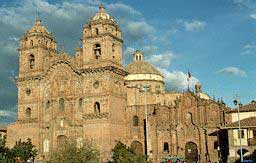
Jesuit Church of La Compania, Cuzco. It is one of the most ornate
churches in Cuzco
.
|

Cathedral, built on Inca ruins, Cuzco. It contains treasures of
Colonial Peru and the tomb of Inca/Spanish historian Garcilaso de la
Vega. |
"Some believe that
Cuzco, meaning "Navel, Omphalus," was so named
because it was the capital, a place chosen for a command post.
Another theory held by many is that the name means "Place of Raised
Stones." If so, the name suits Cuzco’s main attraction - its
astounding megalithic stones.
"....All are agreed by now that while the beautiful
ashlars
(perfectly cut, dressed and shaped stones, like the ones of the
Enclosure) represent a "classical" Inca phase, the
cyclopean walls
belong to an earlier time. For want of clearer answers, scholars
simply call it the Megalithic Age.
"It is a puzzle that still seeks a solution. It is also a mystery
that only deepens as one ascends the promontory of Sacsahuaman.
There, what is assumed to have been an Inca fortress thrusts an even
greater enigma at the visitor.
"The promontory’s name means
Falcon’s Place. Shaped like a triangle
with its base to the northwest, its peak rises some eight hundred
feet above the city below.
Mr. Sitchin explains the sizes of some of the stones in this
fortress, one of them being twenty seven feet high and with a weigh
over 300 tons.
"The style and the period are clearly of the same
cyclopean construction as that of the Megalithic Age remains in
Cuzco, but here they are substantially more massive."
"....Only the colossal walls remain unscathed, mute witnesses that
bespeak an enigmatic age and mysterious builders; for as all studies
have shown, the gigantic stone blocks were quarried miles away and
had to be transported to the site over mountains, valleys, gorges,
and gushing streams.
"How and by whom - and why?
|

SACSAHUAMAN FORTRESS’ RAMPARTS
|

|
Continuing with the
building of the big walls of Sacsahuaman:
"Chroniclers from Spanish conquest times, travelers in recent
centuries, and contemporary researchers, all arrive at the same
conclusion: not the Incas, but enigmatic predecessors with some
supernatural powers.... But no one even has a theory. Why.
"Garcilaso de la Vega wrote of these fortifications that one had no
choice but to believe that they were "erected by magic, by demons
and not by men, because of the number and size of the stones placed
in the three walls...." (the three walls here is referring to the
Falcon’s Place: Mr. Sitchin writes: "separating or protecting this
"developed" area from the rest of the promontory are three massive
walls that run parallel to each other in a zigzag).
|

Pictures where the zigzagging Walls can be
|

appreciated.
|
"....which it is impossible to believe were cut out of quarries,
since the Indians had neither iron nor steel wherewith to extract
and shape them. And how they were brought together is a thing
equally wondrous, since the Indians had neither carts nor oxen nor
ropes wherewith to drag them by manual force. Nor were there level
roads over which to transport them; on the contrary, steep mountains
and abrupt declivities to overcome.
"Many of the stones,"
Garcilaso wrote, "were brought from ten to
fifteen leagues, and especially the stone or rather the rock called
Saycusa or the Tired Stone, because it never reached the
structure.... it defies imagination to conceive how so many and so
great stones could be so accurately fitted together as scarcely to
admit the insertion of a point of a knife between them. Many are
indeed so well fitted that the joint can hardly be discovered...."
Mr. Sitchin continues quoting
Garcilaso:
"a number of Catholic
priests who had suggested that "one cannot conceive how such stones
were cut, carried and set in their places.... unless by diabolic
art."
"Squire.... was enthralled and puzzled by many other features of
these stone colossi and of the other rock faces of the area. One
such feature was the three gateways through the row of walls, one of
which was called the Gate of Viracocha. This gateway was a marvel of
engineering sophistication.
"All chroniclers related that this central gateway, like the other
two at the wall’s extremes, could be blocked by lowering large,
especially fitted stone blocks into the openings. These stone
blockers and the mechanisms for their raising and lowering (to open
and block the gateways) were removed at some ancient time, but the
channels and grooves for them can still be discerned.
"Behind the line of walls the promontory was the site of an
agglomeration of structures, some undoubtedly built in Inca times.
That they were built on the remain of earlier structures is
probable; that they had nothing to do with a maze of subterranean
tunnels is certain....
"....that the Incas used the promontory for a last stand against the
Spaniards is a matter of historical record. That they had put
structures atop it is also evident from the remaining masonry. But
that they were not the original builders at the site is further
evidenced by their recorded inability to transport even one
megalithic stone.
"The attempt-that-failed is reported by
Garcilaso in regard to the
Tired Stone. According to him, one of the Inca master-masons who
wished to enhance his fame decided to haul up the stone from where
the original builders had dropped it and use it as his defensive
structure.
"More than 20,000 Indians brought this stone up, dragging
it with great cables. Their progress was very slow, for the road up
which they came is rough and has many steep slopes to climb and
descend.... On one of these slopes, as a result of carelessness on
the part of the bearers who failed to pull evenly, the weigh of the
rock proved too much for the strength of those controlling it, and it
rolled over down the slope and killed three or four thousand
Indians."
According to this tale, then, the only times
the Incas attempted to
haul up and lift into place a cyclopean stone - they failed.
Obviously, then, they were not the ones who had brought up, cut and
shaped lifted into place, with a mortarless fitting, the hundreds of
the other cyclopean stones.
|

Ancient Ruin Walls of the Old Empire, predating Inca; Phiquillacta,
Peru
|
"....An earlier traveller,
W. Bryford Jones (Four Faces of Peru,
1967), stated in amazement of the massive stone blocks:
"They could
only have been moved, I felt, by a race of giants from another
world...."
Hanz Helfritz.... said of the incredible cyclopean walls
of Sacsahuaman: "The impression is created that they have stood
there from the very beginning of the world."
Long before them, Hiran Bingham.... did not accept the native
tradition tale of the stones having been shaped by "softening" them
by rubbing the stones together with a magical herb....
Mr. Sitchin
asks the question:
"....Who was it that could lift and hold up such a cyclopean stones
to rub them against each other?
"....And so we come full circle back to the
Andeans legends; only
they explain the megalithic builders by claiming that there had been
gods and giants in these lands, and an Old Empire, and kingship that
began with a divine golden wand.
Return
|























































